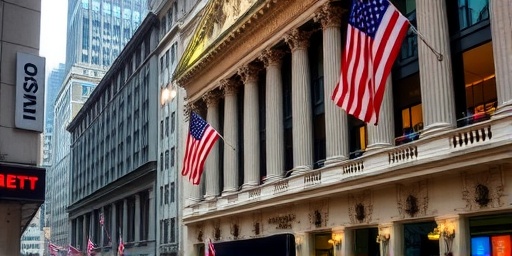Sharp Swings Rock Dow, S&P 500, and Nasdaq in Chaotic Trading Week
In a week that felt more like a rollercoaster than a steady climb, Wall Street experienced unprecedented volatility, with the Dow Jones Industrial Average plummeting over 800 points on Wednesday before rebounding nearly 600 points by Friday’s close. The S&P 500 index, a broad measure of the stock market, swung wildly between a 2.5% gain and a 3.1% loss in a single day, while the tech-heavy Nasdaq Composite saw even sharper fluctuations, dipping into bear market territory mid-week. This tumult has laid bare the fragile investor confidence gripping U.S. markets, as traders grapple with overlapping fears of inflation, supply chain disruptions, and potential Federal Reserve rate hikes.
- Sharp Swings Rock Dow, S&P 500, and Nasdaq in Chaotic Trading Week
- Economic Indicators Ignite Fresh Fears of Recession and Inflation Spiral
- Retail Investors Flock to Safe Havens as Big Money Shifts Strategies
- Wall Street Analysts Warn of Prolonged Uncertainty and Policy Risks
- Outlook Points to Cautious Trading and Potential Fed Pivot Ahead
The chaos began early Monday when disappointing manufacturing data revealed a contraction in factory activity for the first time in over two years, sending ripples through the stock market. Investors, already on edge from last month’s CPI report showing inflation at 7.7%, pulled back aggressively, leading to a $2.5 trillion wipeout in market value across major indices. "This isn’t just noise; it’s a signal that investor confidence is eroding fast," said Michael Santoli, a senior markets commentator at CNBC, during a live broadcast. By Thursday, a surprise jobs report showing 428,000 new positions eased some recession worries, sparking a partial recovery, but the damage to sentiment lingered.
Volatility, as measured by the CBOE Volatility Index (VIX), often dubbed Wall Street‘s "fear gauge," spiked to 32.45 on Wednesday—its highest level since the early days of the COVID-19 pandemic. This surge underscores how quickly sentiment can shift in an uncertain economic landscape, where every data release feels like a potential landmine for the markets.
Economic Indicators Ignite Fresh Fears of Recession and Inflation Spiral
At the heart of this week’s stock market volatility lies a cocktail of troubling economic indicators that have investors questioning the sustainability of the post-pandemic recovery. The Institute for Supply Management’s (ISM) manufacturing index fell to 48.4 in November, dipping below the 50 threshold that separates growth from contraction and marking the first such reading since the initial lockdowns of 2020. This data point alone triggered a sell-off in industrial and cyclical stocks, sectors that had been market darlings earlier in the year.
Compounding the unease, retail sales figures released mid-week showed a modest 0.3% increase, far below economists’ expectations of 0.7%, hinting at cooling consumer spending amid rising prices for essentials like gasoline and groceries. Inflation remains the elephant in the room: the Producer Price Index (PPI) jumped 8.6% year-over-year in October, the largest advance since records began in 2010, fueling bets that the Federal Reserve will accelerate its tapering of bond purchases and potentially hike interest rates sooner than anticipated.
"The markets are pricing in a hawkish Fed response, but the volatility stems from the uncertainty of how aggressive they’ll be," noted economist Lydia DePillis in an interview with Bloomberg. Investor confidence, already battered by a summer of delta variant surges and supply bottlenecks, took another hit as bond yields climbed, with the 10-year Treasury yield touching 1.65% before retreating. This yield spike pressured growth stocks, particularly in technology, where valuations rely heavily on low-interest environments.
Global factors amplified the domestic jitters. China’s ongoing property crisis, exemplified by the woes of developer Evergrande, raised concerns about spillover effects on U.S. exporters, while Europe’s energy crunch threatened to disrupt transatlantic trade. In total, the week saw over $1.1 trillion in market capitalization evaporate from the S&P 500, highlighting how interconnected and reactive today’s markets have become.
Retail Investors Flock to Safe Havens as Big Money Shifts Strategies
The fragility of investor confidence was starkly evident in the divergent behaviors of retail and institutional players during this volatile period. Platforms like Robinhood and Webull reported a 40% surge in trading volume, with everyday investors piling into defensive assets such as consumer staples and utilities ETFs. Gold prices, a traditional safe haven, climbed to $1,820 per ounce mid-week, while Bitcoin, often seen as digital gold, experienced its own swings, dropping 10% before stabilizing.
In contrast, hedge funds and pension managers adopted a more cautious stance, with data from Goldman Sachs indicating a net selling of $45 billion in equities—the largest weekly outflow since March 2020. "Investor confidence isn’t just about numbers; it’s about psychology, and right now, the crowd is spooked," remarked Sarah Chen, a portfolio manager at BlackRock, in a Reuters op-ed. This shift underscores a broader trend: as volatility escalates, smaller investors are learning hard lessons about risk, often at the expense of high-flying meme stocks that dominated earlier rallies.
Sector performance painted a clear picture of shaken confidence. Energy stocks bucked the trend, rising 4.2% on crude oil prices nearing $80 a barrel, but technology lagged with the Nasdaq falling 2.8% for the week. Financials, sensitive to interest rate expectations, posted modest gains of 1.1%, as banks positioned for higher yields. A survey by the American Association of Individual Investors (AAII) showed bullish sentiment dropping to 22.5%, the lowest in six months, while bearish views climbed to 48.2%—a wide gap signaling deep unease in the markets.
- Key Shifts in Investor Behavior: Increased allocations to bonds and cash equivalents, up 15% week-over-week according to Morningstar data.
- Retail Trading Peaks: Over 2.5 million daily trades on major apps, driven by options activity in volatile names like Tesla and GameStop.
- Institutional Caution: Mutual funds reduced equity exposure by 3%, per EPFR Global reports.
This bifurcation highlights how Wall Street‘s volatility is not just testing professional traders but also reshaping the landscape for the millions of new entrants who joined the stock market during the pandemic boom.
Wall Street Analysts Warn of Prolonged Uncertainty and Policy Risks
Veteran voices from the trading floors and boardrooms issued stark warnings this week, emphasizing that the current volatility is symptomatic of deeper cracks in investor confidence. JPMorgan Chase’s chief market strategist, Marko Kolanovic, penned a note to clients predicting "sustained choppiness" through the first half of 2022, citing geopolitical tensions in Ukraine and Taiwan as additional wild cards. "The stock market’s fragility is exposed when every tweet from the Fed or data miss can swing billions," he wrote, referencing Chair Jerome Powell’s recent comments on inflation’s persistence.
Other experts echoed these concerns. At a virtual panel hosted by the Council on Foreign Relations, former Fed Governor Kevin Warsh argued that "investor confidence will remain elusive until the central bank provides clearer guidance on its exit strategy from stimulus." Quants and algorithmic traders, who dominate high-frequency trading, also adapted, with Citadel Securities reporting a 25% increase in volatility-hedging products like VIX futures.
Regulatory scrutiny added another layer of tension. The SEC announced plans to review market structure reforms in light of recent swings, prompting debates on circuit breakers and short-selling rules. "Volatility isn’t inherently bad, but unchecked it erodes trust in the markets," said SEC Commissioner Hester Peirce in a statement. Meanwhile, corporate America felt the pinch: third-quarter earnings from bellwethers like Boeing and Caterpillar missed estimates due to supply issues, further denting optimism.
Looking at historical parallels, this week’s action recalls the 2018 "Volmageddon," when the VIX doubled overnight, but analysts note key differences. Today’s environment features higher inflation and a tighter labor market, potentially buffering against a full downturn. Still, with the Fed’s December meeting looming, the consensus is that investor confidence hangs by a thread, vulnerable to any policy misstep.
Outlook Points to Cautious Trading and Potential Fed Pivot Ahead
As Wall Street catches its breath from this turbulent week, the road ahead suggests more of the same volatility, with investor confidence likely to remain tentative until clearer economic signals emerge. December’s consumer price index, due next week, could either calm nerves or ignite fresh selling if it exceeds the forecasted 6.8% year-over-year gain. Market futures are pricing in a 70% chance of a rate hike by March 2022, per CME FedWatch Tool data, which could stabilize inflation but pressure stock valuations further.
Opportunities may arise in undervalued sectors. Analysts at Morgan Stanley recommend overweighting healthcare and industrials, which showed resilience amid the swings, while underweighting consumer discretionary amid spending fatigue. "The markets are at an inflection point; rebuilding investor confidence will require not just data beats but policy predictability," advised Fidelity’s Jurrien Timmer in a client webinar.
Broader implications extend beyond trading floors. Pension funds, holding trillions in equities, face allocation headaches, potentially leading to higher retirement contribution demands. Globally, emerging markets like those in Latin America could see capital flight if U.S. volatility persists, exacerbating currency pressures. For everyday investors, financial advisors urge diversification: a mix of 60% equities, 30% bonds, and 10% alternatives to weather the storm.
In the coming months, eyes will be on corporate guidance during earnings season, starting in January, and any Omicron variant developments that could disrupt supply chains anew. While the stock market has rebounded from worse, this week’s events serve as a reminder of its interconnected fragility. Traders are bracing for more bumps, but history shows that volatility often precedes opportunity—for those with the stomach to stay the course.









